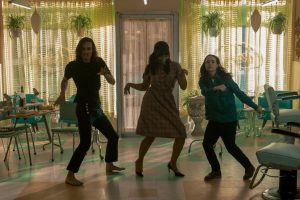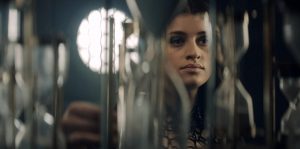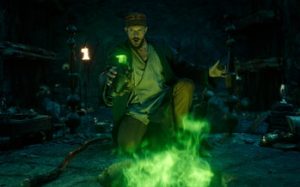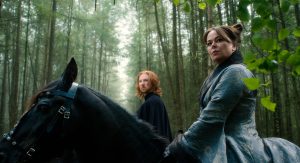The first season of Netflix’s The Umbrella Academy was, no questions asked, an exhilarating and entertaining ten hours of twists, turns and time travel. But the second season, which picks up mere moments after the season one finale and finds the seven members of the dysfunctional Hargreeves family split up throughout the 1960’s, takes the series to a whole new high: The Umbrella Academy elevates all the best elements of the first season, arriving at a delicate yet necessary balance between goofy, comic-booky fun and epic, emotional drama, while simultaneously working to revise or improve parts of the story that were heavily criticized, such as pacing issues and certain problematic character beats (ahem, romanticized incest).

When the season opened (turns out, the clip released by Netflix a few days ago and advertised as the first scene isn’t quite the first), I enjoyed a raw moment of catharsis because it felt so wonderful to be back, spending more time with these characters – each and every one of whom, with the obvious exception of Luther (Tom Hopper), is truly delightful. They’re each so unique, so independent, and so beautifully messed up. Their family dynamic is what makes the series click. And they thrive both on their own and as a team – which stands in contrast to season one, where many of their individual subplots felt meandering or aimless compared to the few and far between team-up moments. In season two, each member of the Umbrella Academy is going after their destiny with purpose and determination, making them each more compelling and significantly more dangerous, as their agendas clash repeatedly.
Once again kicking off the events of the season, Number Five (Aidan Gallagher) is, in my opinion, the most fascinating of our seven antiheroes: having successfully teleported the Umbrella Academy out of reach of the apocalypse at the end of season one, Five quickly realizes, with a little help from Hazel (Cameron Britton), that the end of the world is going to follow the Academy wherever or whenever they go. This time, it’s not Vanya Hargreeves with the white violin in the theater – it’s an impending Soviet invasion sparked by the assassination of President John F. Kennedy. Much like in season one, Five takes the initiative – hunting for clues across the timeline, doing his best to find his family and unite them, and colliding violently with the bureaucratic Commission – but this time around, he seems more personally invested in the fate of the world, and we watch as his frigid facade begins to crack under pressure and he has to resort to more uncharacteristic methods: for instance, hand-to-hand combat. We finally get to see the once-legendary killer in action, and his fight scenes (and there are several!) are well worth the wait.

Second to Five but not far behind him is Vanya (Elliot Page), who has had a massive character overhaul since the season one finale. It’s hard to say too much without risking spoilers, but Vanya isn’t quite the same person she was when she blew up the moon and destroyed the world with her supersonic abilities. In fact, she’s actually kind of…happier? If I had to criticize, I’d even say she’s a bit too calm about everything that happened. That being said, while her portrayal in this season starts out a bit weak, by the finale she’s fully come into her own and is rocking a new personality and some cool new powers that I definitely can’t talk about. What’s not a spoiler is that Elliot Page gets to dance again this season, and Vanya actually has moves! Still a little awkward, but a definite improvement from the…disjointed shoulder shuffle.
Speaking of dancing, we have to go off-topic for a moment and talk about the soundtrack. I have my suspicions that it won’t be as instantly iconic as season one’s, which gave the series a reputation for setting all sorts of scenes to absolutely random yet brilliant songs, but there’s still a lot of hits. A lot. I want to highlight Daniela Andrade’s “Crazy” and Boney M.’s “Sunny”, which plays over an unforgettable Klaus (Robert Sheehan) scene.

Back on topic, just like that. Klaus and his ghostly companion Ben (Justin H. Min) arrive in the decade before any of their siblings and have the most time to ease seamlessly into the 60’s. Klaus, predictably, gets entangled with a cult and somehow becomes their leader and nonsensical prophet, a duty with many perks which he later regrets as the cult starts following him obsessively around Dallas. But the zaniest Umbrella Academy member isn’t just there for comedic relief and drug-fueled, psychedelic hijinks; he also nails every dramatic character beat he gets. Ben does too, but all of Ben’s best scenes count as spoilers.
Then there’s Allison (Emmy Raver-Lampman), whose relationship with Vanya was arguably the thematic core of season one. She’s just as much in the spotlight here, leading an entire Black community into the civil rights campaign alongside her new husband, Raymond (Yusuf Gatewood), who is thankfully not her brother – no matter how many times Allison might claim that she and Luther aren’t “technically” related, I’m with Klaus on this one: once you have to use the word “technically”, there’s already a problem. But Allison’s biggest issue isn’t her brother anymore: it’s her superpower, which she has to refrain from using, even when it would be so easy to use it to get whatever she wants, from free clothes to equality to vengeance.
Surprisingly, I have to say Luther was my next favorite, but that says more about how little I liked Diego (David Castañeda) this season than it does about any radical improvements from the Umbrella Academy’s emotionally stunted strongman. If there is one highlight in the character’s portrayal, it’s that he’s mostly comedic relief now. And I’m happy to report that the series doesn’t try to excuse or apologize for the fact that he subjected his own sister to permanently damaging physical, mental and emotional abuse: he gets called out several times for his part in causing the apocalypse. I think I may have just enjoyed seeing him get constantly beaten down, walked all over and blatantly ignored whenever he tried to roll out the usual spiel about being the Number One and the leader of the family. Is that mean? I love to hate him: that’s better than just hating him, right?
As for Diego, well, the truly unattractive new hairstyle isn’t the only problem with his character. One of my favorites from season one, he slowly but inevitably sank to the bottom of my list over the course of season two, thanks to being the only character still saddled with a self-inflicted hero complex. What makes Diego tolerable is that whenever he’s onscreen, he’s usually accompanied by his love interest, the enigmatic Lila (Ritu Arya), a fellow patient at the mental hospital where he’s been imprisoned. Lila’s role is crucial to the season and the series going forward, but again those pesky spoilers get in the way of us talking about any of that.

Amongst the rest of the supporting cast, the standouts are Marin Ireland as Sissy – a charming Texan farmwoman who has dreams of making a great escape from her married life – and Colm Feore, who reprises the role of Sir Reginald Hargreeves: but as a younger, even more nefarious version of the character. Viewers won’t learn everything about his history from this season, but they will get some tantalizing glimpses of who he really is, and what his plans for the Umbrella Academy were all along.
This season might seem to initially lack a strong presence from the villains, since the guy from the trailers with the fishbowl head is only in a couple of scenes and the trio of Swedes are mostly annoying obstacles rather than fully developed characters (though if you didn’t enjoy the Swedish rendition of Adele’s “Hello” on the soundtrack, I don’t know what to say to you), but that changes once another character comes on the scene. And the villains show up in full force for the finale, so don’t worry.

The Umbrella Academy season two leaves off with a definite hook for a third season – and since I imagine that this season will be eaten up by audiences, I think we’re going to get that third season as soon as possible. This started out as one of those series’ that I liked but felt a little embarrassed for liking so much: now, I don’t have any hesitation about saying that The Umbrella Academy is a masterpiece. It’s got the cool visuals and the thrilling action you want from a superhero story, but it’s got a lot more than that: it’s got heart, soul, and wit in equal measures, all tied up in one perfect package. That package also comes with a killer soundtrack, meme-worthy humor (Klaus’ parable of the scorpion and the frog being my favorite example), and a whole lot of weirdness – what’s not to love?
Series Rating: 9.5/10








